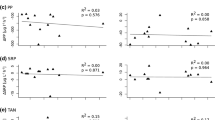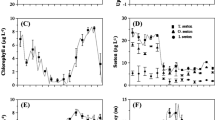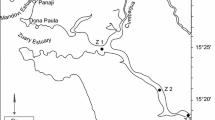Abstract
The growth and mortality of experimentally-rafted Mytilus edulis L. of known age at 7 locations in a northern estuary (Damariscotta River, Maine, USA) were related to environmental temperatures and to the presence or absence of various potential food sources. All particles were regarded as potential food substrates. Growth decreased appreciably at sites where water temperatures exceeded 20°C, but mussels survived a wide range of elevated temperature exposures, ranging from 0 to 149 degree-days in excess of 20°C. The maximum temperature was 25°C. Mortalities of mussels at all sites but did affect the extent of mortality, which increased abruptly in late summer, when water temperatures were declining. Differences in degree-days of exposure to elevated temperatures did not influence the timing of mortality, which occurred synchronously at all times, but did affect the extent of mortality, which ranged from 35 to 90%. The period of high mortality was preceded by a rapid decline in phytoplankton standing crop. Total particle concentrations decreased during this period, but the shift toward larger particles suggests that there was little, if any, decrease in total volume of material in the seston, at least through August. It is suggested that living phytoplankton provided the critical energy source for these mussels, and that the mortalities were caused by rapidly reduced ration at a time of metabolic stress. The role of temperature and the possible role of the gametogenic cycle are discussed. In addition, the feeding efficiency of M. edulis may have decreased during this period due to an increase in mean particle diameter. Chlorophyll was divided into a nannoplankton fraction (<-20 μm) and a larger fraction (>20 μm). A smaller size criterion for this distinction is proposed for future studies. The importance of nannoplankton to the primary production of this estuary and the role of nannoplankton and nannoplankton-sized particles in the diet of mussels in nature are discussed.
Similar content being viewed by others

Literature Cited
Baird, R. H.: Measurement of condition in mussels and oysters. J. Cons. perm. int. Explor. Mer 23, 249–257 (1958)
Banse, K.: Rates of growth, respiration and photosynthesis of unicellular algae as related to cell size—a review. J. Phycol. 12, 135–140 (1976)
Bayne, B. L.: Physiological changes in Mytilus edulis induced by temperature and nutritive stress. J. mar. biol. Ass. U.K. 53, 39–58 (1973)
Bayne, B. L. (Ed.): Marine mussels: their ecology and physiology, 506 pp. New York: Cambridge University Press 1976
Bayne, B. L., R. J. Thompson and J. Widdows: Some effects of temperature and food on the rate of oxygen consumption by Mytilus edulis L. In: Effects of temperature on ectothermic organisms, pp 181–193. Ed. by W. Wieser. Heidelberg: Springer-Verlag 1973
Bayne, B. L., R. J. Thompson and J. Widdows: Physiology. I. In: Marine mussels: their ecology and physiology, pp 121–206. Ed. by B. L. Bayne. Cambridge University Press 1976
Bayne, B. L., J. Widdows and C. Worrall: Some temperature relationships in the physiology of two ecologically distinct bivalve populations. In: Physiological responses of marine biota to pollutants, pp 375–400. Ed. by F. J. Vernberg, A. Calabrese, F. Thurberg and W. Vernberg. New York: Academic Press 1977
Coulthard, H. S.: Growth of the sea mussel. Contr. Can. Biol. Fish. 4, 123–136 (1929)
Durbin, E. G., R. W. Krawiec and T. J. Smayda: Seasonal studies on the relative importance of different size fractions of phytoplankton in Narragansett Bay (USA). Mar. Biol. 32, 271–282 (1975)
Dussart, B. M.: Les différentes catégories de plancton. Hydrobiologia 26, 72–74 (1965)
Foster-Smith, R. L.: The effect of concentration of suspension on the filtration rates and pseudofaecal production for Mytilus edulis, Cerastoderma edule, Venerupis pullastra. J. exp. mar. Biol. Ecol. 17, 1–22 (1975a)
Foster-Smith, R. L.: The role of mucus in the mechanism of feeding in three filter-feeding bivalves. Proc. malac. Soc. Lond. 41, 571–588 (1975b)
Gilmartin, M.: The primary production of a British Columbia fjord. J. Fish. Res. Bd Can. 21, 505–538 (1964)
Gonzales, J. and P. Yevich: Responses of an estuarine population of the blue mussel Mytilus edulis to heated water from a steam generating plant. Mar. Biol. 34, 177–189 (1976)
Gordon, D. C., Jr.: A microscopic study of organic particles in the North Atlantic Ocean. Deep-Sea Res. 17, 175–185 (1970)
Haven, D. and R. Morales-Alamo: Filtration of particles from suspension by the American oyster, Crassotrea virginica. Biol. Bull. mar. biol. Lab., Woods Hole 139, 248–264 (1970)
Hutchins, L. W.: The bases for temperature zonation in geographical distribution. Ecol. Monogr. 17, 325–335 (1947)
Incze, L. S. and R. H. Cody: The size distribution of particulates and phytoplankton in the Damariscotta River Estuary, Lincoln County, Maine. Maine Sea Grant Technical Report. (In press) (1980). (Copies available from: University of Maine Sea Grant Publications Office, University of Maine, Orono, Maine 04469, USA)
Incze, L. S. and R. A. Lutz: Mussel cultivation: an East Coast Perspective. In: Mussel culture and harvest: a North American perspective, pp 99–140. Ed. by R. A. Lutz. Amsterdam: Elsevier 1980
Incze, L. S., B. Porter and R. A. Lutz: Experimental culture of Mytilus edulis L. in a northern estuarine gradient: growth, survival, and recruitment. Proc. Wld Maricult. Soc. 9, 523–541 (1978). (world Mariculture Society, Baton Rouge: Louisiana State University Press)
Kinne, O.: The effect of temperature and salinity on marine and brackish water animals. I. Temperature. Oceanogr. mar. Biol. A. Rev. 1, 301–340 (1963)
Kinne, O.: Temperature: animals-invertebrates. In: Marine ecology, Vol. I. Environmental factors, Part I. pp 407–514. Ed. by O. Kinne. London: Wiley-Interscience 1970
Lutz, R. A. and B. Porter: Experimental culture of blue mussels Mytilus edulis L. in heated effluent waters of a nuclear power plant. Proc. Wld Maricult. Soc. 8, 427–445 (1977)
Malone, T. C.: The relative importance of nannoplankton and netplankton as primary producers in the California Current System. Fish. Bull. U.S. 69, 799–820 (1971a)
Malone, T. C.: The relative importance of nannoplankton and netplankton as primary producers in tropical oceanic and neritic phytoplankton communities. Limnol. Oceanogr. 16, 633–639 (1971b)
Malone, T. C.: Diurnal rhythms in netplankton and nannoplankton assimilation ratios. Mar. Biol. 10, 285–289 (1971c)
Malone, T. C.: Light-saturated photosynthesis by phytoplankton size fractions in the New York Bight, USA. Mar. Biol. 42, 281–292 (1977)
McAlice, B. J.: A preliminary oceanographic survey of the Damariscotta River estuary, Lincoln County, Maine. Maine Sea Grant Technical Report No. 3, 27 pp. 1977 (Copies available from: University of Maine Sea Grant Publications Office, University of Maine, Orono, Maine 04469, USA)
McCarthy, J. J., W. Rowland Taylor and M. E. Loftus: Significance of nanoplankton in the Chesapeake Bay estuary and problems associated with the measurement of nanoplankton productivity. Mar. Biol. 24, 7–16 (1974)
McNabb, C. D.: Enumeration of freshwater phytoplankton concentrated on the membrane filter. Limnol. Oceanogr. 5, 57–61 (1960)
Møhlenberg, F. and H. U. Rissgård: Efficiency of particle retention in 13 species of suspension feeding bivalves. Ophelia 17, 239–246 (1977)
Moore, J. K.: Refinement of a method for filtering and preserving marine phytoplankton on a membrane filter. Limnol. Oceanogr. 8, 304–305 (1963)
Newell, R. C.: Biology of intertidal animals, 555 pp. London: Logos Press 1970
Pearce, J. B.: Thermal addition and the benthos, Cape Cod Canal. Chesapeake Sci. 10, 227–233 (1969)
Prosser, C. L.: Comparative animal physiology, 966 pp. Philadelphia: W. B. Saunders 1973
Read, K. R. H.: Respiration of the bivalve molluscs Mytilus edulis L. and Branchidontes demissus plicatulus Lamarck as a function of size and temperature. Comp. Biochem. Physiol. 7, 89–101 (1962)
Read, K. R. H. and K. B. Cumming: Thermal tolerance of the bivalve molluscs Modiolus modiolus (L.), Mytilus edulis L., and Brachidontes demissus Dillwyn. Comp. Biochem. Physiol. 22, 149–155 (1967)
Schulte, E. H.: Influence of algal concentration and temperature on the filtration rate of Mytilus edulis. Mar. Biol. 30, 331–341 (1975)
Sheldon, R. W. and T. R. Parsons: A practical manual on the use of the Coulter Counter in marine science, 65 pp. Toronto: Coulter Electronic Sales, Co. Toronto 1967. (Copies available from: Coulter Electronic Sales Co., Ltd., Toronto, Canada)
Strickland, J. D. H. and T. R. Parsons: A practical handbook of seawater analysis. Bull. Fish. Res. Bd Can. 167, 1–311 (1968)
Thompson, R. J. and B. L. Bayne: Active metabolism associated with feeding in the mussel, Mytilus edulis. J. exp. mar. Biol. Ecol. 9, 111–124 (1972)
Ütermohl, H.: Zur Vervollkommnung der quantitativen Phytoplankton Methodik. Mitt. int. Verein. theor. angew. Limnol. 9, 1138 (1958)
Vahl, O.: Efficiency of particle retention in Mytilus edulis L. Ophelia 10, 17–25 (1972)
Vernberg, F. J. and W. B. Vernberg: Thermal influence on invertebrate respiration. Chesapeake Sci. 10, 234–240 (1969)
Wallis, R. L.: Thermal tolerance of Mytilus edulis of Eastern Australia. Mar. Biol. 30, 183–191 (1975)
Warren, C. E. and G. E. Davis: Laboratory studies on the feeding, bioenergetics, and growth of fish. In: The biological basis of freshwater fish production, pp 175–214. Ed. by S. D. Gerking. Oxford: Blackwell 1967
Wells, H. W. and I. E. Gray: The seasonal occurrence of Mytilus edulis on the Carolina coast as a result of transport around Cape Hatteras. Biol. Bull. mar. biol. Lab., Woods Hole 119, 550–559 (1960)
Widdows, J.: Effect of temperature and food on the heart beat, ventilation rate and oxygen uptake of Mytilus edulis. Mar. Biol. 20, 269–276 (1973a)
Widdows, J.: The effects of temperature on the metabolism and activity of Mytilus edulis. Neth. J. Sea Res. 7, 387–398 (1973b)
Widdows, J.: Physiological adaptation of Mytilus edulis to cyclic temperatures. J. comp. Physiol. 105, 115–128 (1976)
Widdows, J.: Combined effects of body size, food concentration and season on the physiology of Mytilus edulis. J. mar. biol. Ass. U.K. 58, 109–124 (1978a)
Widdows, J.: Physiological indices of stress in Mytilus edulis. J. mar. biol. Ass. U.K. 58, 125–142 (1978b)
Widdows, J. and B. L. Bayne: Temperature acclimation of Mytilus edulis with reference to its energy budget. J. mar. biol. Ass. U.K. 51, 827–843 (1971)
Wieser, W.: Effects of temperature on ectothermic organisms, 298 pp. Heidelberg: Springer-Verlag 1973
Winberg, G. G.: Rate of metabolism and food requirement of fishes. Nauchn. Trudy belorussk. gos. Univ. V. I. Lenina, Minsk 1–253 (1956). [Transl. Ser. Fish. Res. Bd. Can. No. 194 (1960)]
Yentsch, C. S. and J. H. Ryther: Relative significance of the netplankton and nanoplankton of Vineyard Sound. J. perm. int. Explor. Mer 24, 231–238 (1959)
Zeitzschel, B.: The quantity, composition and distribution of suspended particulate matter in the Gulf of California. Mar. Biol. 7, 305–318 (1970)
Author information
Authors and Affiliations
Additional information
Communicated by I. Morris, West Boothbay Harbor
Rights and permissions
About this article
Cite this article
Incze, L.S., Lutz, R.A. & Watling, L. Relationships between effects of environmental temperature and seston on growth and mortality of Mytilus edulis in a temperate northern estuary. Mar. Biol. 57, 147–156 (1980). https://doi.org/10.1007/BF00390733
Accepted:
Issue Date:
DOI: https://doi.org/10.1007/BF00390733



